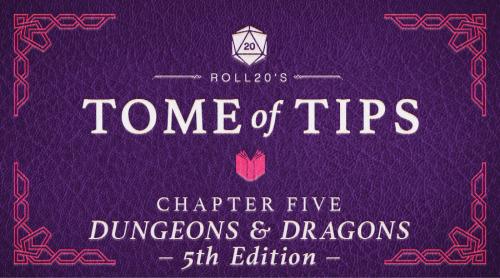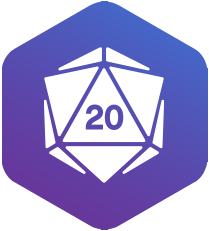
The Roll20 Team
Dust off your reading spectacles–the Tome of Tips has returned.
Today’s entry is a little different than past chapters. Today, we’re going to be talking about a game system–namely, Dungeons & Dragons: 5th Edition. Maybe you’ve heard of it!
5th Edition is the most popular system on Roll20 by far, and it’s played in a variety of ways.
And there’s no wrong way to play. Whatever your flavor of D&D is, we think it’s awesome because it’s yours.
What we’re here to do today is tell you about some features of the D&D 5E character sheet that you might not know about–features that could help you better play the game _your _way.
Are you getting the most out of your games? Do you know everything Roll20 has to offer your 5th Edition playgroup? Read on to find out!
Use the Dungeons & Dragons: 5th Edition Character Sheet to... Click the bubble icon on abilities and spells to send their description to the chat
We’ll start with a simple one that just might save you and your playgroup a bundle of time.
Did you know you can click the word bubble icon next to abilities and spells to send their descriptions to the chat? Save your DM the trouble of paging through the compendium in a separate tab and share the details of your spell’s effect with the party with just a single click.
Here are some details about spell descriptions you might not know: In the D&D 5E sheet, there are actually two types of spell outputs. Spellcards don’t roll damage or show the Difficulty Class (or DC) needed to save from that spell. Attacks roll damage and display DCs, but they don’t show any description–at least not by default. To change that, just jump into the settings menu for a spell by clicking the cog here.
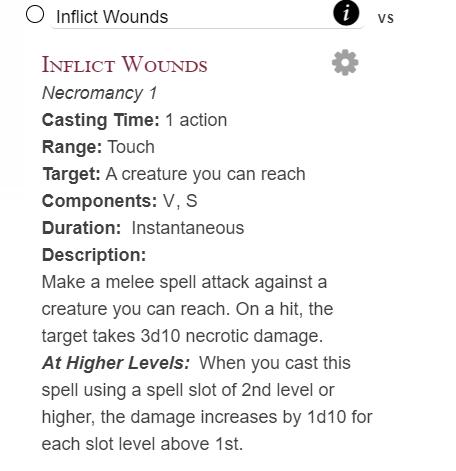
Scroll down the settings and toggle the INCLUDE SPELL DESCRIPTION IN ATTACK field to On.
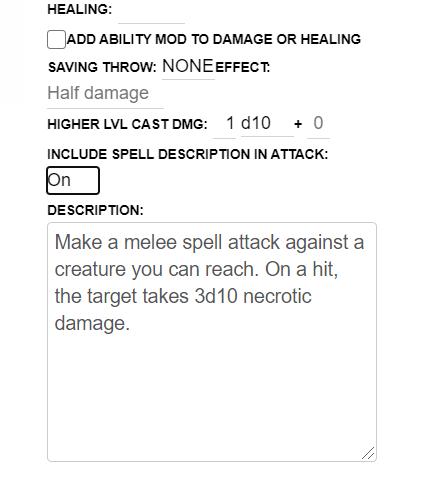
Presto! Further, if you’d like to change the description of the spell–to shorten it, add in some signature details about your character’s spellcasting, or what-have-you–the text box just below this field in the Settings menu is, in fact, editable.

The results, in chat:

Add various modifiers to an item for easy-to-build Magic Items and more
The MODS field on items is often overlooked, but it could save a shrewd DM some time when crafting magic items on-the-fly.

MODS is a text field that accepts various AC or magic bonuses that will then figure into that item’s calculations automatically. For example, you could give a chestplate AC +1 to make sure that any character equipped with that item gets a +1 bonus to their armor class.
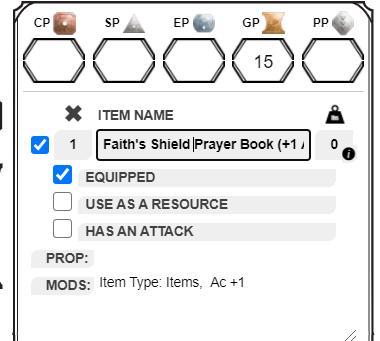
The MODS field, then, is perfect for creating magic items quickly. You can set a modification for:
-Armor Class
-Attacks (For Items that have an Item Type including the word “weapon”)
-Attack Modifier
-Damage (and Damage Type)
-Secondary Damage (and Secondary Damage Type)
-Range
-Spells (Including spell attack and spell DC)
-Stats
-Saving Throws
-Skills
Don’t forget the space in between (for example, Ac +1, not Ac+1)!
Keep track of items, ammo, and consumables in your inventory
Keeping track of depleting resources in Roll20 is easy–so easy, in fact, that it happens more or less automatically.
Drag-and-drop an item (like arrows) from the compendium to a character’s inventory and a resource-tracker will populate automatically.
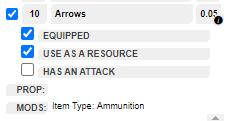
Then, just make sure the USE AS A RESOURCE checkbox is selected on the item’s settings. From there, a player will just need to manually deplete the number next to the item to keep track of its use.
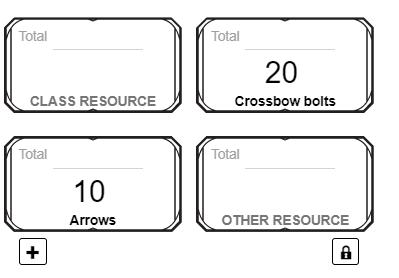
As this number goes down, the number in your inventory will go down, too.
But there’s a way to automate that process as well! The 5th Edition OGL by Roll20 Companion API Script helps keep track of those resources automatically. It ties resources into attacks and abilities so that a player doesn’t have to manually deplete their inventory. Like all APIs, it requires a Pro account to use.
For more information on this API script, check out our Zendesk article here.
The Dungeons & Dragons 5th Edition Character Sheet is powerful and versatile. These are just some of the ways it can make running a game of 5E in Roll20 even easier. There are dozens of tricks and tips to uncover and discover. But the most important thing about your game is just that: It’s yours. Use what works for you!
That’s all for this installment of the Tome of Tips. Got a topic you’d like to see us dive into in a future entry? Let us know in the comments or over on Twitter, and as always: Thanks for playing with us.
As a reminder, we’re matching donations to Code2040, “a nonprofit activating, connecting and mobilizing the largest racial equity community in tech to dismantle the structural barriers that prevent the full participation and leadership of Black and Latinx technologists in the innovation economy.” Learn more and donate through our Tiltify campaign here: http://roll20.io/Tiltify-Code2040
